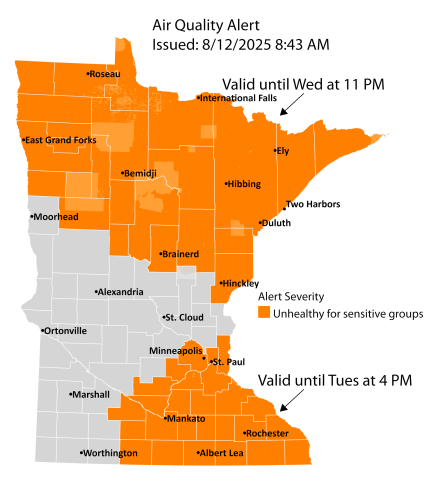
Air quality is expected to reach the orange AQI category in southeast and northern Minnesota, which is unhealthy for sensitive groups.
The Minnesota Pollution Control Agency (MPCA) has extended an air quality alert for southeast and northern Minnesota. The alert is now in effect until 4 p.m. on Tuesday, Aug. 12, for southeast Minnesota and until 11 p.m. on Wednesday, Aug. 13 for northern Minnesota. The affected area includes the Twin Cities metro area, Brainerd, Albert Lea, Rochester, Hinckley, Winona, Mankato, Bemidji, East Grand Forks, International Falls, Two Harbors, Hibbing, Ely, Duluth, Roseau, and the Tribal Nations of Mille Lacs, Prairie Island, Leech Lake, White Earth, Red Lake, Grand Portage, and Fond du Lac.
Heavy ground-level smoke continues to linger across southeast Minnesota Tuesday morning. This smoke will continue to impact air quality across this region through the afternoon before finally leaving the state around 4 p.m. Meanwhile, northwest winds will bring a narrow band of ground-level smoke from wildfires in Canada into northern Minnesota Tuesday morning. Smoke will reach as far south as Detroit Lakes, Brainerd, and Hinckley by the end of the day on Tuesday. High pressure will move into the region on Wednesday and winds will become light. Ground-level smoke will stall and continue to impact the northern one-third of the state on Wednesday. The smoke should begin to disperse and air quality should improve beginning Wednesday evening.
Fine particle levels are expected to reach the orange air quality index (AQI) category, a level considered unhealthy for sensitive groups, across southeast and northern Minnesota. This area includes the Twin Cities metro area, Brainerd, Albert Lea, Rochester, Hinckley, Winona, Mankato, Bemidji, East Grand Forks, International Falls, Two Harbors, Hibbing, Ely, Duluth, Roseau, and the Tribal Nations of Mille Lacs, Prairie Island, Leech Lake, White Earth, Red Lake, Grand Portage, and Fond du Lac. In the orange area, sensitive groups should limit prolonged or heavy exertion and time spent outdoors.